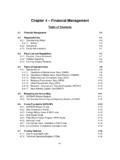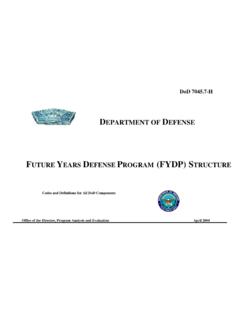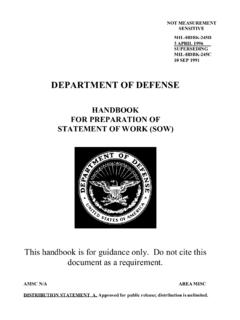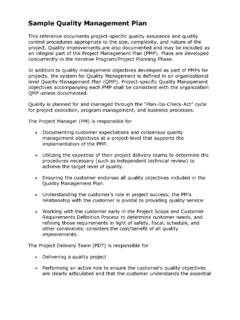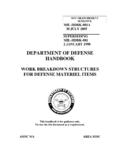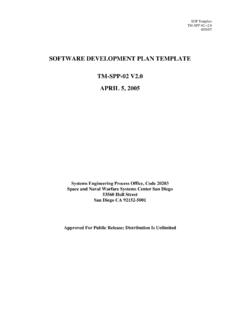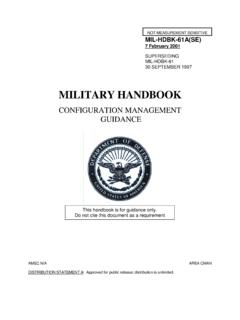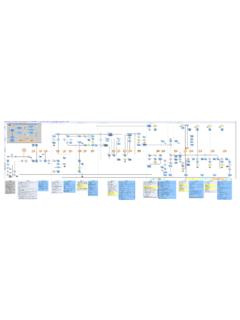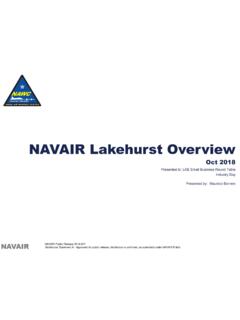Transcription of Performance Based Logistics - AcqNotes
1 Performance Based Logistics : A Program Manager s Product Support Guide Total Life Cycle Systems Management 2 FOREWORD This document supersedes Product Support: A Program Manager s Guide to Buying Performance , published in November 2001, which has been commonly known as The PBL Guide. Performance - Based Logistics : A Program Manager s Product Support Guide captures the progress that has been made in implementing PBL over the past three years and presents up-to-date guidance Based on the lessons learned from the application of PBL to support activities throughout the Armed Services. 3 Table of Contents Executive Summary ..4 The Supportability Product Support Boundaries ..7 TLCSM and PBL ..9 Total Life Cycle Systems Management (TLCSM) ..9 Performance Based Logistics (PBL).
2 11 PBL Metrics ..12 Implementing PBL Implementation Model ..14 The Product Support Manager and Product Support Integrator(s) ..24 Performance - Based PBL Business Case Analysis ..35 Legislative and Statutory Financial Management Issues ..40 Key Product Support Issues ..43 Configuration Management ..43 Data Management ..44 DMSMS & Obsolescence ..47 Corrosion Prevention and Control ..47 Earned Value Sustained Materiel Readiness ..48 Case Studies/Success Stories ..50 F/A-18E/F ..50 Common Ground Station ..50 F-117 ..51 TOW Shadow Tactical UAV ..54 NAVICP: Aircraft NAVICP: APU/TLS ..55 RTOC ..55 References and Resources ..57 The DAU ACC and Logistics Community of Service Tools and Databases ..58 DoD and Service Statutory 4 Executive Summary Performance - Based Logistics (PBL) is the preferred Department of Defense product support strategy to improve weapon system readiness by procuring Performance , which capitalizes on integrated Logistics chains and public/private partnerships.
3 The cornerstone of PBL is the purchase of weapon system sustainment as an affordable, integrated package, Based on output measures such as weapon system availability, rather than input measures, such as parts and technical services. The Quadrennial Defense Review (QDR) and the Defense Planning Guidance (DPG) directed the application of PBL to new and legacy weapon systems. PBL Implementation is also mandated by DoD Directive This guide is a tool for program managers (PMs) and Product Support Managers (PSM) as they design product support strategies for new programs or major modifications, or as they reengineer product support strategies for existing, fielded systems. It presents a methodology for implementing a PBL product support strategy. PBL delineates outcome Performance goals of systems, ensures that responsibilities are assigned, provides incentives for attaining these goals, and facilitates the overall life-cycle management of system reliability, supportability, and total ownership costs.
4 It is an integrated acquisition and Logistics process for providing weapon system capability. Designing and Assessing Supportability In DoD Weapon Systems: A Guide to Increased Reliability and Reduced Logistics Footprint (The Supportability Guide) is the DoD document that defines a framework for determining and continuously assessing system product support throughout the lifecycle. It uses the Defense Acquisition Management Framework (See the DoD 5000 series) and systems engineering processes to define appropriate activities and required outputs throughout a system s life cycle to include those related to sustainment of fielded systems. A System Operational Effectiveness (SOE) framework is included that shows the linkage between overall operational effectiveness and system and product support Performance .
5 This is accomplished through the application of a robust, life cycle systems engineering process to identify and continuously assess supportability requirements for the system. The Supportability Guide provides a template for the PM when assigned, or responsible activities, to use in defining and assessing their program activities to meet QDR and DPG objectives and DoD policy requirements throughout the system life cycle. The term PM, as used here, refers to the entire, integrated program office team, including program office personnel, other government personnel, and industry. This guide emphasizes designing for increased reliability and reduced Logistics footprint, and providing effective, affordable product support through Performance - Based Logistics (PBL) strategies. Implementation of this disciplined approach, including systems engineering analysis tools such as Requirements Definition, Architecture Development, Failure Mode Effects and Criticality Analysis (FMECA), Fault Tree Analysis (FTA), and Reliability Centered Maintenance (RCM), will produce a Maintenance Task Analysis (MTA) directly linked to a system s Reliability, Maintainability, and Supportability (RMS) attributes.
6 The MTA is Based upon detailed technical tasks including those determined by application of an RCM assessment of the design of the system. Close collaboration between engineers 5and logisticians is critically important during system design and development and throughout the life cycle. These tasks are further refined through PBL Business Case Analysis to determine a cost effective, sustainable product support solution to meet the user s needs in an operational environment. A Total System Product Support Package, which identifies support requirements Based upon the reliability and maintainability of the system in order to meet top-level operational and support metrics (see section , PBL Metrics), is defined in conjunction with the user. The PM and the user then document these support requirements in a Performance - Based agreement.
7 Continuous assessment of in-service system Performance will identify needs for system improvements to enhance safety, reliability, maintainability, affordability, obsolescence, corrosion, and other Life Cycle Logistics (LCL) attributes. The transition to PBL as a product support strategy will evolve Based on determination of the provider s product support capability to meet set Performance objectives. The major shift from the traditional approach to PBL product support emphasizes what program managers provide to the user. Instead of buying set levels of spares, repairs, tools, and data, the new focus is on buying a predetermined level of availability to meet the warfighter s objectives. 6 Introduction The Department of Defense (DoD) is emphasizing weapons system Performance throughout the life cycle to provide assured levels of system readiness with a focus on integrated system management and direct accountability.
8 The DoD 5000 acquisition regulations direct the integration of acquisition and Logistics to enhance the warfighters capability to carry out their mission. DoD s strategic goals for acquisition Logistics , as stated in the most recent Quadrennial Defense Review (QDR), Joint Vision 2020, and the Focused Logistics Campaign Plan (FLCP), include: Project and sustain the force with minimal footprint. Reduce cycle times to industry standards. Implement Performance - Based Logistics . The Joint Capabilities Integration and Development System (JCIDS) translates those strategic acquisition Logistics goals into capabilities needs that define systems. Supportability should be a Key Performance Parameter (KPP) consideration defined by JCIDS and fulfilled through Performance - Based Logistics . Performance - Based Logistics (PBL) is the purchase of support as an integrated, affordable, Performance package designed to optimize system readiness and meet Performance goals for a weapon system through long-term support arrangements with clear lines of authority and responsibility.
9 Simply put, Performance - Based strategies buy outcomes, not products or services. PBL is DoD s preferred product support method. DoD policy states that: PMs shall develop and implement Performance - Based Logistics (PBL) strategies that optimize total system availability while minimizing cost and Logistics footprint. Sustainment strategies shall include the best use of public and private sector capabilities through government/industry partnering initiatives, in accordance with statutory requirements. (DoDD , ) In the PBL environment, a Government/Industry Team is a key long-term relationship that is developed among public and private stakeholders contractually and/or with Performance agreements. The team is Based upon a foundation of building trust whereby there is mutual accountability for achieving the outcome Performance goals in managing reliability, supportability and total ownership cost over the life cycle of a weapon system.
10 This guide, Performance Based Logistics : A Program Manager s Product Support Guide, provides a PBL implementation tool for the PM, Product Support Manager and the product support team. After an initial overview of Total Life Cycle Systems Management (TLCSM) and PBL, it presents a 12-step PBL implementation process and further discussion of Key Elements in that process. It concludes with a selection of real-world PBL examples. References and additional information are provided in Section 6. 7 The term PM, as used here, refers to the entire, integrated program office team, including program office personnel, other government personnel, and industry; or to the sponsor if no PM has been assigned. Acquisition Logistics professionals should apply the information in this guidebook in context with two other key documents: The Supportability Guide (see below), which lays a foundation for PBL by emphasizing supportability in systems engineering, and the Product Support Boundaries (see below), which establishes the boundaries within which PBL should be implemented.
